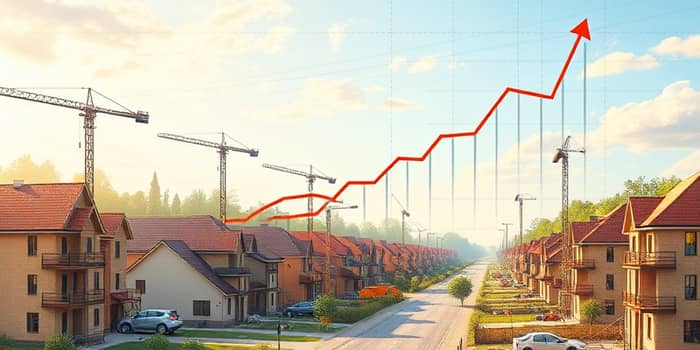
The U.S. housing market is confronting a period of unprecedented challenges as borrowing costs escalate. Recent data reveal a sharp decline in housing starts, signaling that elevated mortgage rates are casting a long shadow over new construction and overall market sentiment.
In this comprehensive analysis, we explore the underlying causes of this downturn, regional disparities, expert insights, and what lies ahead for builders and buyers alike.
May 2025 witnessed a dramatic 9.8% month-over-month drop in total housing starts, falling to a seasonally adjusted annual rate of 1.256 million units. This followed an 11.4% plunge in March, the largest four-month low since the end of last year. Such volatility underscores how sensitive construction activity has become to financing conditions.
Breaking these figures down reveals more nuance. Single-family starts tumbled 14.2% in March to 940,000 annualized units, a 9.7% decrease compared to the same month in 2024. Multifamily construction, while somewhat more resilient, still fell by 3.5% to 384,000 units in March.
At the core of this slowdown are mortgage rates hovering near 7%. After peaking at 23-year highs in late 2023, the average 30-year fixed rate has eased slightly to 6.94% but remains historically elevated. This persistent rate pressure on buyers has discouraged many prospective homeowners from entering the market.
Data from Freddie Mac indicate a nearly 12% drop in purchase mortgage applications in 2023, reflecting how soaring borrowing costs stifle demand for new home construction. Even modest Federal Reserve rate cuts have failed to push mortgage rates substantially below 6%, limiting their positive impact on affordability.
Not all regions experienced uniform declines. In March 2025, the West endured a staggering 30.9% fall in housing starts, while the South saw a 17.1% drop. In contrast, the Midwest rebounded with a 76.2% surge, and the Northeast eked out a 1.4% gain.
These disparities reflect local economic conditions, availability of land, and differences in labor costs. Builders in the West continue to grapple with stringent land-use regulations and high materials expenses, while Midwestern markets benefit from lower input costs and more streamlined permitting processes.
Although housing starts are waning, inventory has begun to climb from historic lows. Early 2025 figures show 481,000 new homes for sale—the highest level since 2007—and 385,000 speculative homes, the most since 2008. Yet, this uptick in supply has not fully balanced the market; builders remain cautious.
New home sales reflect this caution. May 2025 sales dropped 13.7% to an annualized pace of 623,000 units, marking a 6.3% year-over-year decline. With supply rising to a 9.8-month inventory, conditions are shifting from a seller’s to a buyer’s market.
Builders cite a combination of factors constraining supply: elevated construction costs, persistent labor shortages, and the weight of high mortgage rates. As a result, many focus on higher-margin luxury projects, leaving entry-level buyers with limited options.
Industry voices warn that affordability pressures will persist. Buddy Hughes, chairman of the National Association of Home Builders (NAHB), notes that elevated rates and costly materials are especially squeezing entry-level supply. “Without relief on financing costs, first-time buyers may be forced to delay purchases,” he cautions.
J.P. Morgan projects that the U.S. housing market will remain largely frozen through 2025, with growth under 3% barring a significant drop in rates. Meanwhile, Bankrate forecasts mortgage rates will hover around 6–7%, keeping home price appreciation down to 2% this year, compared to 4.5% last year.
Amid this challenging environment, stakeholders can take proactive steps. Builders might:
Buyers, on the other hand, should consider locking in current rates, exploring adjustable-rate mortgages, and researching government assistance programs that offset down payments and closing costs.
The decline in housing starts amid higher mortgage rates paints a complex picture of a market under strain but not devoid of opportunity. While affordability challenges and construction headwinds are real, innovation in building techniques and targeted policy interventions can foster resilience.
As we navigate the remainder of 2025, monitoring rate movements and inventory trends will be critical. Through strategic adaptations, the housing industry can rebound, offering new homes to those ready to embark on the path to ownership.
References













